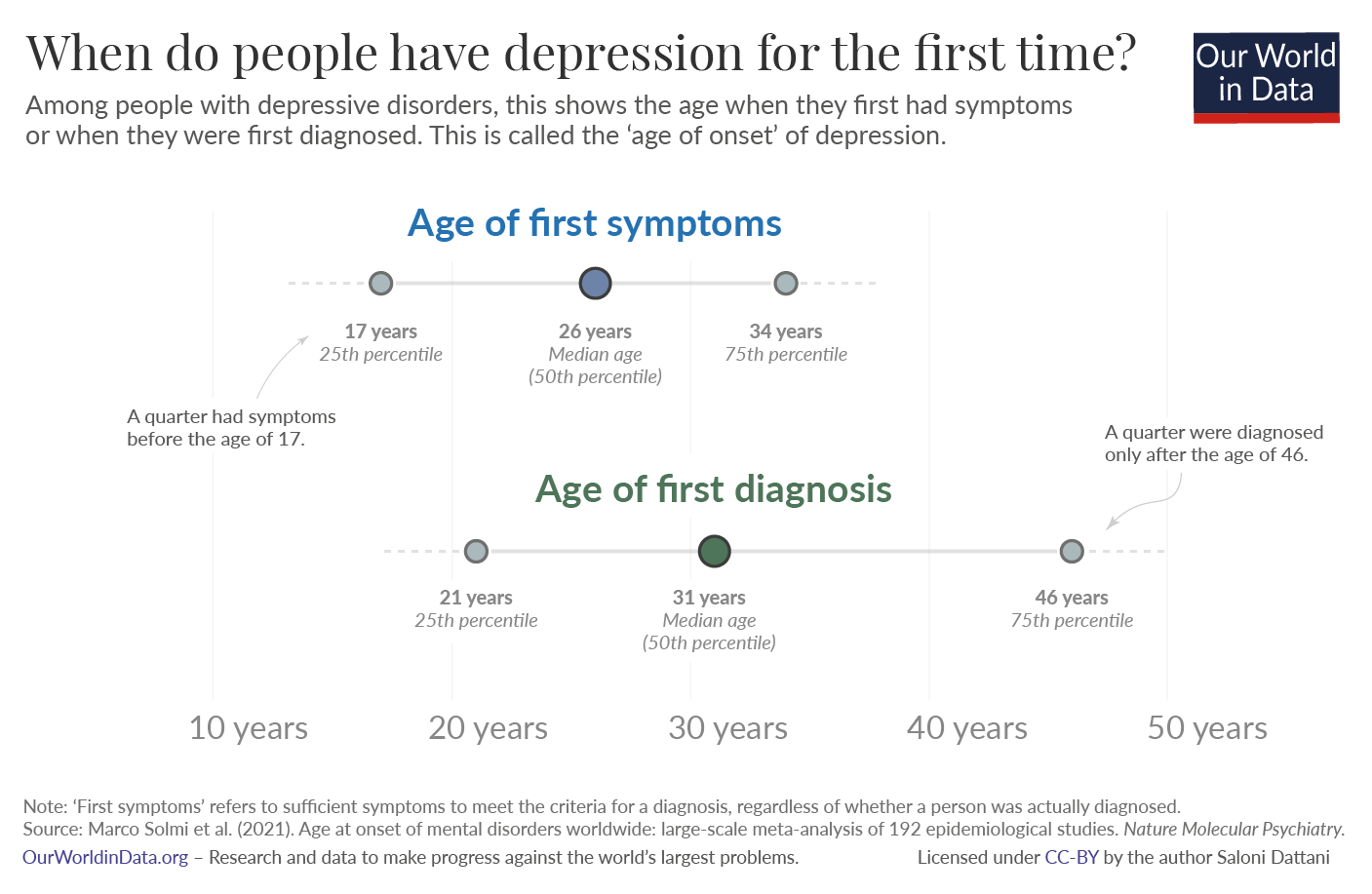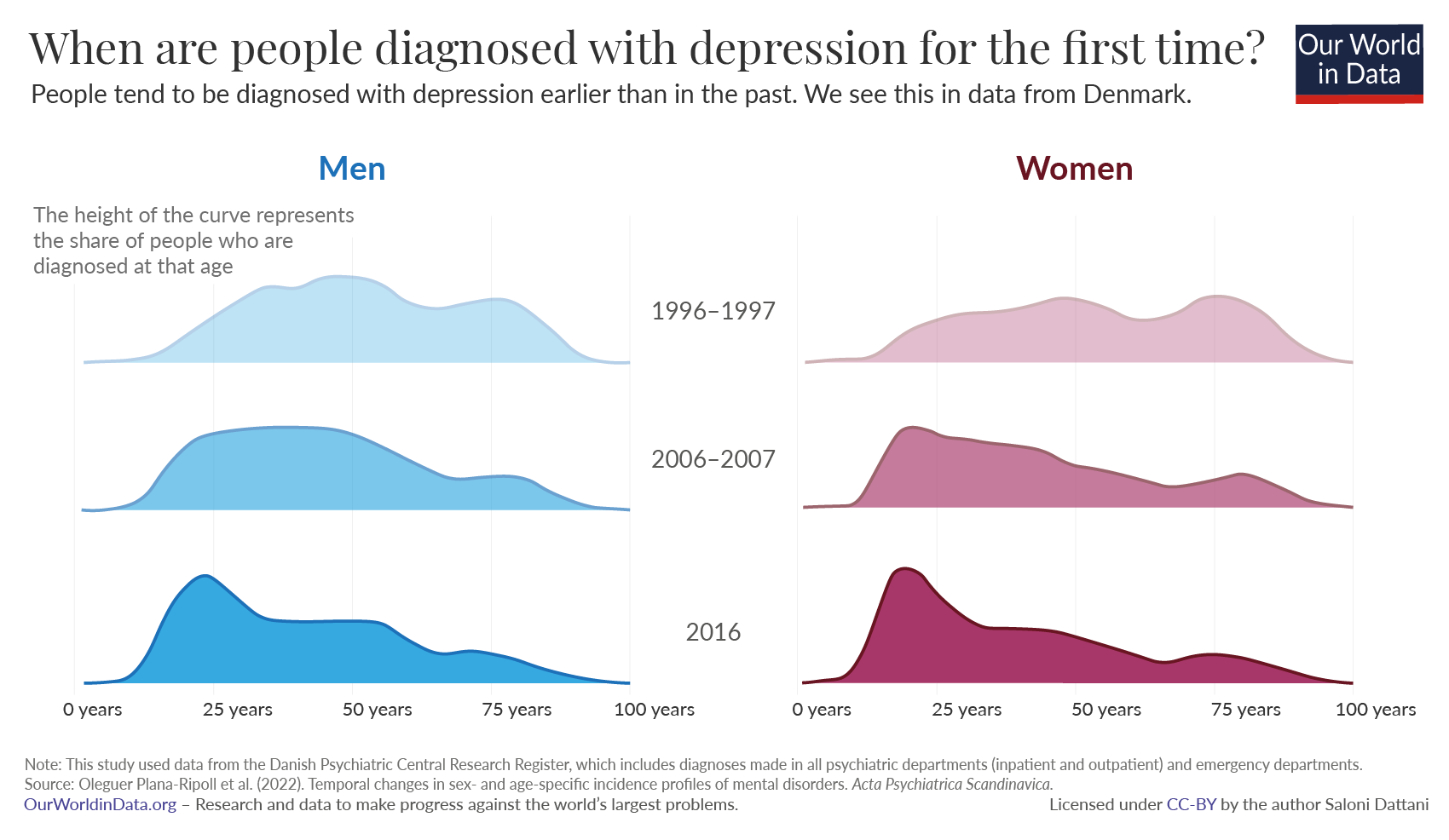At what age do people experience depression for the first time?
People are being diagnosed with depression at an earlier age than in the past because of increased openness to mental health disorders and improved diagnostic guidelines.
Depression can affect people over long periods of their lives. Some people experience this condition continuously, while for others, it occurs in episodes – with long stretches without symptoms.
But when do people tend to experience it for the first time?
The age when people experience depression for the first time is called the ‘age of onset.’
But this can be measured in different ways. One way is to find out when people first had the symptoms of depression. This is done by interviewing them about symptoms they have had in their lives so far – some people describe having symptoms in the past that meet the diagnostic criteria of depression. Another way is to find out whether people have been diagnosed with the condition, and the age when they were diagnosed with it for the first time.
This chart shows the age of onset of depression based on a meta-analysis by Marco Solmi and colleagues. The researchers combined data from studies that took place around the world.1

As the data shows, on average, people experienced the symptoms of depression 5 years before they were diagnosed. When measured on the basis of symptoms, the median age of onset was 26. When measured on the basis of a diagnosis, the median age of onset was later, at 31 years old. The data also shows that there is a wide range for both symptoms and diagnosis. One quarter had not experienced symptoms before the age of 34. For diagnosis this was even later: one-quarter were not diagnosed before the age of 46.
People are diagnosed earlier than in the past
In many countries, mood disorders such as depression and bipolar disorder are being diagnosed earlier than they were in the past.2
We see clear evidence of this in the data in the chart.
This data comes from a study conducted in Denmark, which looked at the age when people were first diagnosed with mental disorders. They used data from across the population.3
In 1996 the age of diagnosis varied widely. Young, middle-aged and old people all had a similar chance of being diagnosed with depression for the first time. By 2016, people were diagnosed much earlier. They were much more likely to be diagnosed with depression when they were young adults than later in their lives.

There are several reasons that this age distribution has shifted.
First, people have become more willing to seek treatment for mental health conditions.4
Second, there are more guidelines on how to diagnose conditions in children and adolescents than in the past. In Denmark, children and adolescents have become more likely to be seen by professionals and screened for mental health conditions, and have regular check-ups for psychiatric symptoms at schools.5
This means they are more likely to be diagnosed during their first episode of depression. In the past, they may have been diagnosed later – perhaps when they were actually having their second or third episode – or not diagnosed at all.
Our understanding of the age of onset of mental health disorders is important, because mental health screening and treatment are often guided by age. They are limited for young people in some countries.6
By recognising that depression can occur early in life, we will have a greater ability to help those who need it.
Acknowledgements
I would like to thank Hannah Ritchie and Max Roser for reading drafts of this post and very helpful comments to improve it.
Endnotes
Solmi, M., Radua, J., Olivola, M., Croce, E., Soardo, L., Salazar de Pablo, G., Il Shin, J., Kirkbride, J. B., Jones, P., Kim, J. H., Kim, J. Y., Carvalho, A. F., Seeman, M. V., Correll, C. U., & Fusar-Poli, P. (2021). Age at onset of mental disorders worldwide: Large-scale meta-analysis of 192 epidemiological studies. Molecular Psychiatry. https://doi.org/10.1038/s41380-021-01161-7
The studies included in this meta-analysis measured this age in different ways. Some studies looked at the age when symptoms of the disorder began, some looked at when they were first diagnosed, and others looked at when they first received treatment for the disorder or were first hospitalized for it. The median age of onset for some disorders, such as substance use disorders, mood disorders and anxiety disorders was earlier when it was measured by first symptoms than when it was measured by first diagnosis or first hospitalization.
Medici, C. R., Videbech, P., Gustafsson, L. N., & Munk-Jørgensen, P. (2015). Mortality and secular trend in the incidence of bipolar disorder. Journal of Affective Disorders, 183, 39–44. https://doi.org/10.1016/j.jad.2015.04.032
Mauz, E., & Jacobi, F. (2008). Psychische Störungen und soziale Ungleichheit im Geburtskohortenvergleich. Psychiatrische Praxis, 35(07), 343-352. https://www.thieme-connect.com/products/ejournals/abstract/10.1055/s-2008-1067557
Scott, J., Etain, B., Azorin, J. M., & Bellivier, F. (2018). Secular trends in the age at onset of bipolar I disorder – Support for birth cohort effects from international, multi-centre clinical observational studies. European Psychiatry, 52, 61–67. https://doi.org/10.1016/j.eurpsy.2018.04.002
Plana‐Ripoll, O., Momen, N. C., McGrath, J. J., Wimberley, T., Brikell, I., Schendel, D., Thygesen, M., Weye, N., Pedersen, C. B., Mors, O., Mortensen, P. B., & Dalsgaard, S. (2022). Temporal changes in sex‐ and age‐specific incidence profiles of mental disorders—A nationwide study from 1970 to 2016. Acta Psychiatrica Scandinavica, acps.13410. https://doi.org/10.1111/acps.13410
Plana‐Ripoll, O., Momen, N. C., McGrath, J. J., Wimberley, T., Brikell, I., Schendel, D., Thygesen, M., Weye, N., Pedersen, C. B., Mors, O., Mortensen, P. B., & Dalsgaard, S. (2022). Temporal changes in sex‐ and age‐specific incidence profiles of mental disorders—A nationwide study from 1970 to 2016. Acta Psychiatrica Scandinavica, acps.13410. https://doi.org/10.1111/acps.13410
Schomerus, G., Schwahn, C., Holzinger, A., Corrigan, P. W., Grabe, H. J., Carta, M. G., & Angermeyer, M. C. (2012). Evolution of public attitudes about mental illness: A systematic review and meta-analysis: Evolution of public attitudes. Acta Psychiatrica Scandinavica, 125(6), 440–452. https://doi.org/10.1111/j.1600-0447.2012.01826.x
Angermeyer, M. C., Matschinger, H., & Schomerus, G. (2013). Attitudes towards psychiatric treatment and people with mental illness: changes over two decades. The British Journal of Psychiatry, 203(2), 146-151.
While 0.4% of children and adolescents were in contact with a psychiatric department in 2001, that figure was 3.3% in 2018. The Danish Health Data Authority. (2019) Key numbers about health care in Denmark (in Danish). https://sundhedsdatastyrelsen.dk/da/tal-og-analyser/analyser-og-rapporter/sundhedsvaesenet/noegletal-om-sundhedsvaesenet
Schmidt, M., Schmidt, S. A. J., Adelborg, K., Sundbøll, J., Laugesen, K., Ehrenstein, V., & Sørensen, H. T. (2019). The Danish health care system and epidemiological research: From health care contacts to database records. Clinical Epidemiology, Volume 11, 563–591. https://doi.org/10.2147/CLEP.S179083
Babatunde, G. B., van Rensburg, A. J., Bhana, A., & Petersen, I. (2021). Barriers and Facilitators to Child and Adolescent Mental Health Services in Low-and-Middle-Income Countries: A Scoping Review. Global Social Welfare, 8(1), 29–46. https://doi.org/10.1007/s40609-019-00158-z
Kieling, C., Baker-Henningham, H., Belfer, M., Conti, G., Ertem, I., Omigbodun, O., Rohde, L. A., Srinath, S., Ulkuer, N., & Rahman, A. (2011). Child and adolescent mental health worldwide: Evidence for action. The Lancet, 378(9801), 1515–1525. https://doi.org/10.1016/S0140-6736(11)60827-1
Cite this work
Our articles and data visualizations rely on work from many different people and organizations. When citing this article, please also cite the underlying data sources. This article can be cited as:
Saloni Dattani (2022) - “At what age do people experience depression for the first time?” Published online at OurWorldInData.org. Retrieved from: 'https://ourworldindata.org/depression-age-of-onset' [Online Resource]BibTeX citation
@article{owid-depression-age-of-onset,
author = {Saloni Dattani},
title = {At what age do people experience depression for the first time?},
journal = {Our World in Data},
year = {2022},
note = {https://ourworldindata.org/depression-age-of-onset}
}Reuse this work freely
All visualizations, data, and code produced by Our World in Data are completely open access under the Creative Commons BY license. You have the permission to use, distribute, and reproduce these in any medium, provided the source and authors are credited.
The data produced by third parties and made available by Our World in Data is subject to the license terms from the original third-party authors. We will always indicate the original source of the data in our documentation, so you should always check the license of any such third-party data before use and redistribution.
All of our charts can be embedded in any site.

